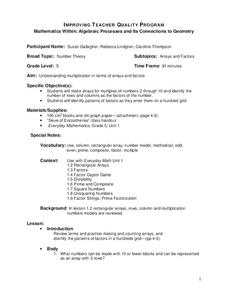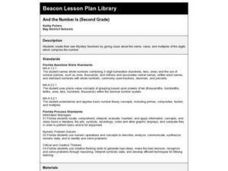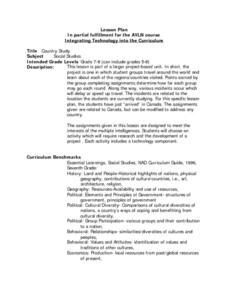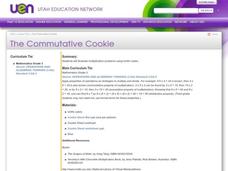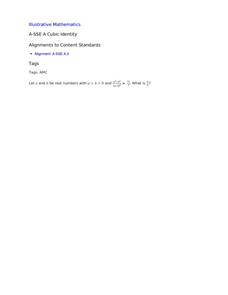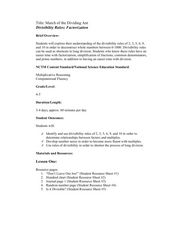Curated OER
New Deck: Percents
Fifth graders observe and demonstrate the meaning of percents by creating a new deck of fifty-two cards. They meet a specified criteria, with a specific percent of the cards being prime numbers, eight's, multiples of five, face cards,...
Curated OER
Mathematics Within: Algebraic Processes and Its Connections to Geometry
Fifth graders discover the connections between algebra and geometry. With a focus on arrays and factors, they are introduced to multiplication. They develop an array for multiples of 2 through 10 and identify the factors of each row....
Curated OER
Patterns in Pascal's Triangle
Students examine the patterns that exist in Pascal's Triangle. They explore multiples and factors. Sudents use an applet to create and color the multiples in Pascal's Triangle.
Curated OER
And the Number Is (Second Grade)
Second graders create Mystery Numbers. They give the class clues about the name, value, and multiples of the digits which make up the number.
Curated OER
Social Studies: Countries and Technology
Students participate in a travel simulation and have just arrived in Canada. After choosing activities to research, they define their methods of exploration and development on plan sheets. Among the scenarios from which they choose...
Curated OER
The Commutative Cookie
Third graders investigate the commutative properties of multiplication and focus upon the setting of cubes in the correct patterns to solve problems. They differentiate between numbers that have multiple factors and prime numbers....
University of California
Roots of the Cold War
When and how did the Cold War begin? To answer this question, you will not find a better-organized, in-depth, activity- and inquiry-based resource than this! Executing best teaching practices throughout, each portion of this inquiry...
Curated OER
Range, Cluster, Gap and Outliers
There are a number of activities here where learners collect and record data, as well as, activities where the likelihood of an event happening is calculated given the experimental probability. Young statisticians organize information...
Curated OER
Discovering New Units
Students use Cuisenaire rods to explore common denominators. In this fractions lesson, students build Cuisenaire representations of fractions, then find their equivalent counterparts to find the common denominator.
Curated OER
Exponential Expressions - Perfect Squares, Square Roots
Color tiles are used to model perfect squares. Alone or in pairs, middle schoolers will find patterns. Afterward, the relationship between perfect squares and roots will be discussed as a whole class.
PBS
Add, Subtract and Multiply Fractions
Your future chefs will appreciate this comprehensive instructional activity where learners practice operations on fractions using pizza and soup analogies. Learners begin with a pizza analogy that requires the learners to...
Illustrative Mathematics
Equivalent fractions approach to non-repeating decimals
Trying to get your class to think of decimals as fractions and vice versa can lead to interesting discussions. After all, we can usually understand quickly that 1/4 is .25 but why is 1/7 not so easy to convert? This activity looks...
Illustrative Mathematics
An Integer Identity
Challenge algebra learners to use the difference of cubes to solve this problem. Once your charges have taken out the factor (a - b), combined the like terms and set them equal to zero, the problem becomes a factorable quadratic...
Curated OER
Investigation - Design Your Own Spinner
Seventh graders use ideas of uncertainty to illustrate that mathematics involves more than exactness when dealing with every day situations. The main standard of this lesson is statistics and probability.
Curated OER
Perfect Numbers
Sixth graders classify numbers as abundant, deficient, or perfect based on the relationship between the number and its factors. They review factor game using the completed lab sheet. When playing the factor game which type of numbers...
Curated OER
March of the Dividing Ant
Students inspect divisibility rules. In this divisibility rules instructional activity, students study the relationship between factorization and the divisibility rules for 2, 3, 5, 6, 9, and 10. Students read One Hundred Hungry Ants and...
Curated OER
Absolute Location
Fifth graders examine the geographic concept of absolute location. Using a variety of resources, they create a life-size classroom grid and locate the coordinates of a point, identify latitude and longitude of different locations, and...
Curated OER
Treaties
Sixth graders research treaties. In this treaties lesson, 6th graders go online to build knowledge about treaties. Students read information and take quizzes. Students write a comparative essay about how the Aboriginal and...
Curated OER
Simplify Expression Using the Order of Operations
Allow learners to explore both the right and wrong way of completing equations with the order of operations. They discuss how the order in which operations are performed affects the outcome of a problem. A fun "trick" using order of...
Curated OER
Sieve of Eratosthenes
Students investigate numbers, ways of representing numbers, relationships among numbers and number systems. They comprehend the meaning of operations and how they relate to each other.
Curated OER
Introductory Algebra Chapter R Review
In this math worksheet, middle schoolers solve the problems and simplify the fractions. Each of the sets is related to the instructional objectives.
Curated OER
Clock Arithmetic and Cryptography
Learners perform basic operations in modular (clock) arithmetic. Students encode and decode messages using shift and affine ciphers. Learners apply their multiplication, division, addition, and subtraction skills.
Curated OER
Number Theory - Week 12
In this number theory worksheet, students study integers and their properties. They explore the Fibonacci Sequence and approximate irrational numbers. This two-page worksheet contains eight problems.
Curated OER
The Quadratic Formula
Students solve quadratic function by completing the square. In this algebra lesson plan, students use the quadratic formula to factor quadratics and find the roots. They graph the parabola and identify its properties.

